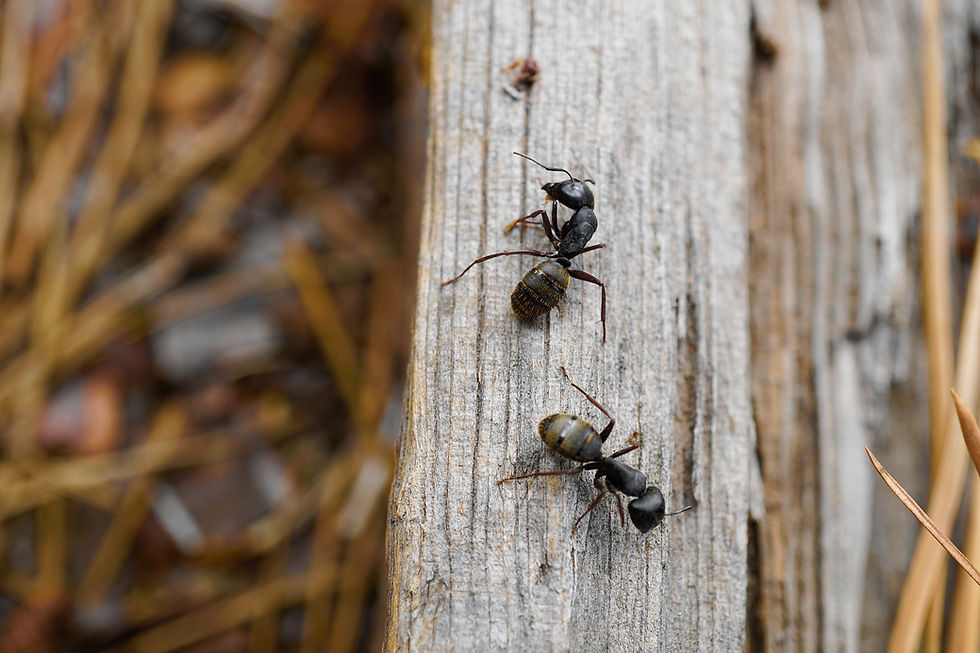Termites: The Silent Destroyers Threatening Your Home and Why You Need Professional Help
- VecPest

- Dec 31, 2024
- 4 min read

Your home is your sanctuary, but for termites, it’s an all-you-can-eat buffet. These tiny pests are capable of causing massive structural damage before you even realize they’re there. Termites don’t just pose a threat to your property—they can also drain your finances and peace of mind if left unchecked.
In this blog, we’ll uncover the hidden dangers of termites, how to spot an infestation, and why professional intervention is critical to protecting your home.
1. Meet the Enemy: What Are Termites?
Hook: You might not see them, but termites could be chewing through your walls right now.
Termites are social insects that live in large colonies and feed on cellulose, a primary component of wood. The most common types include subterranean termites (the most destructive), drywood termites, and dampwood termites. Each type has unique behaviors but shares the same appetite for destruction.
🕵️ Fun Fact: A single subterranean termite colony can contain millions of workers, all focused on one goal: devouring wood.
Practical Tip: Regularly inspect wood structures in and around your home for signs of damage, such as hollow-sounding wood or visible tunnels.
2. The Cost of Termite Damage
Hook: Think termites are just a minor nuisance? Think again—they’re a billion-dollar problem.
Termites cause more than $5 billion in property damage annually in the U.S. alone, and most insurance policies don’t cover termite damage. They can weaken your home’s foundation, walls, and support beams, leading to costly repairs and potentially dangerous structural issues.
📊 Stat Spotlight: The average homeowner spends over $3,000 on termite damage repairs, according to the National Pest Management Association.
Practical Tip: Schedule annual termite inspections to catch infestations early and avoid expensive repairs.
3. Health Impacts of Termites: More Than Just Property Damage
Hook: Termites may not bite you, but they can still affect your health.
While termites don’t transmit diseases, their presence can cause allergies or asthma symptoms. Termite nests can release dust and particles into the air, which may irritate sensitive individuals. Mold often develops in areas with termite activity, compounding health risks.
📢 Quote: “Termite infestations can indirectly affect indoor air quality, especially in humid environments,” says Dr. Nicholas Martin, an environmental scientist.
Practical Tip: Address moisture problems in your home to reduce the risk of termites and related health issues.
4. How to Spot a Termite Infestation
Hook: Termites are masters of stealth—can you spot the warning signs before it’s too late?
Early detection is crucial to preventing extensive damage. Common signs of a termite infestation include:
Mud tubes along walls or foundations
Hollow-sounding wood
Discarded wings near windows or doors
Tiny droppings (frass) resembling sawdust
🔎 Pro Tip: Use a flashlight to inspect dark areas like crawl spaces or basements, where termites often hide.
Practical Tip: Keep a checklist of warning signs to monitor your home regularly and report any suspicious findings to a professional.
5. DIY Termite Control: Why It’s Not Enough
Hook: Killing a few termites won’t solve the problem—the colony is the real culprit.
DIY treatments like sprays or bait traps may provide temporary relief but rarely eliminate an entire colony. Termites often hide deep within walls, foundations, or underground, making them nearly impossible to eradicate without professional tools and expertise.
📢 Quote: “Effective termite control requires understanding their biology and behavior,” says Dr. Michael Waldvogel, an urban entomologist.
Practical Tip: Use DIY solutions only as a stopgap while waiting for professional help to ensure long-term results.
6. Why Professional Termite Control Is Essential
Hook: Termites don’t take a day off, so neither should your defense strategy.
Professional pest control services use advanced tools like thermal imaging, moisture meters, and soil treatments to detect and eliminate termites. Experts can also provide preventative treatments, such as applying termiticides or installing baiting systems to protect your home for years to come.
📊 Stat Spotlight: Homes treated with professional termite control methods are up to 70% less likely to experience reinfestation.
Practical Tip: Hire a pest control company with certifications like the NPMA QualityPro to ensure effective and eco-friendly termite management.
7. Prevention Tips: How to Keep Termites at Bay
Hook: A few small changes can make a big difference in keeping termites out.
Reduce Moisture: Termites thrive in damp environments, so fix leaky pipes and maintain proper ventilation.
Store Wood Properly: Keep firewood and lumber away from your home and off the ground.
Seal Entry Points: Repair cracks in your foundation and walls to block termites’ access.
🌿 Pro Tip: Install physical barriers, such as stainless steel mesh or sand, during construction to prevent termites from reaching wood structures.
Practical Tip: Use mulch sparingly around your home’s foundation, as it can attract termites.
Wrapping Up: Defending Your Home from Termites
Termites are more than just pests—they’re silent destroyers capable of causing significant financial and structural damage. Early detection and professional intervention are your best defenses against these relentless invaders.
Don’t wait for visible damage to take action. Schedule a professional inspection, implement preventative measures, and stay vigilant. After all, your home is your greatest investment—protect it with the attention it deserves.





Comments